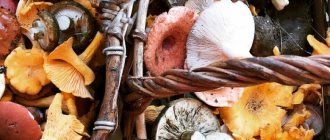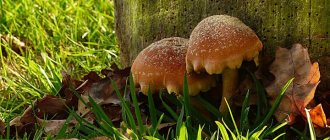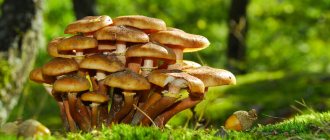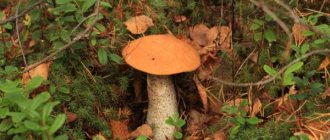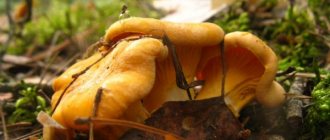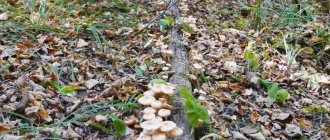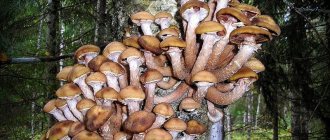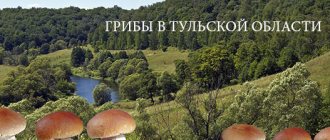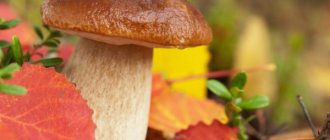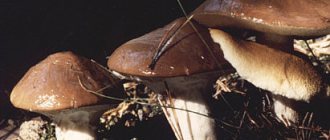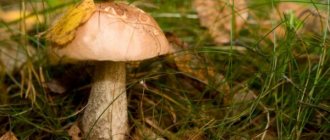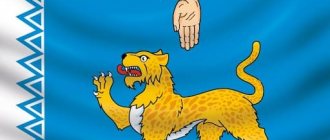General characteristics
In the Urals, the campaign to collect forest resources continues almost all year round.
This region is considered one of the most promising for the development of mushroom production. Crowds of local residents, starting in early spring, head to the taiga for a tasty harvest, which is then salted, fermented, fried and steamed.
Mushrooms are a storehouse of microelements and vitamins. By eating them regularly, you will be able to get rid of many diseases, stimulate the immune system and normalize cholesterol levels in the blood.
All mushrooms have a general classification and are divided into the following groups:
The presence of toxins determines the degree of edibility. Not only the first group is allowed to eat. Inedible and conditionally edible varieties are also used in cooking. Before the main cooking, additional processing, soaking and cooking is carried out. Poisonous mushrooms should not be eaten. It is difficult to remove toxins at home; it is better not to risk life and health.
Edible species
In the Urals, mushrooms are found everywhere and during any season. But not all fruits are edible. To avoid mistakes, it is better to get acquainted with edible species in advance. The most popular in this region include the following:
- White;
- Boletuses;
- Boletus mushrooms;
- Butter;
- Saffron milk caps;
- Volnushki;
- Russula;
- Squeakers;
- Milk mushrooms;
- Rogatiki.
Summer and autumn honey mushrooms are so common that some people pass by, considering them weeds.
White
The white mushroom is called the king of the forest
The porcini mushroom cannot be confused with others; it is memorable. He is called the king of the forest. In the Urals they came up with other names for it:
It has a beautiful powerful stem, cylindrical and tapering towards the cap. Her color is white. The surface is brown, sometimes slightly reddish. The pulp is dense, with a strong aroma. At the bottom of the cap there is a spongy layer of white or slightly yellowish color. The color never changes when cut. Even when dry, the pulp remains snow-white. This is an important quality of the mushroom. That's why the mushroom was called white.
Whites grow in mixed forests from early July to October. They prefer dry, non-boggy soils.
Boletus
The boletus has a second name - Redhead, which it received because of the color of its cap. Its lower layer becomes brown with age. The shape of the leg is cylindrical, reaching a height of 18 cm. A mesh in the form of dark scales is clearly visible on it.
A characteristic feature is the blue discoloration of the cut. The aroma is strong and pleasant. The pulp is dense, homogeneous, soft. Boletuses grow in deciduous and mixed forests under aspens and other deciduous trees. The best collection time is from July to the end of September.
Time for a "silent hunt"
There is an abundance of mushrooms in the forests around Kurgan
September in our area is the time of “quiet hunting” or, as it is sometimes called, “grooming”. For many Kurgan residents, mushroom picking is both a favorite gambling hobby and a way to “cheaply and cheerfully” replenish the family grocery basket. From early morning on weekdays, busy retired grandmothers with spacious bags rush into the forest. On weekends, entire families load into cars and go to treasured mushroom places that have been tested for years, kept a deep secret from neighbors and co-workers from generation to generation. Lonely, melancholy mushroom pickers jump on a bus or train to wander around the suburban forests with bags, baskets and backpacks, breathe in the fresh air of pine forests and birch groves, and listen to the singing of birds. And, of course, everyone strives to bring home at least five or six kilograms of strong buttermilk or two or three buckets of selected milk mushrooms. The main dream of the average mushroom picker is a white mushroom or boletus, the “king of mushrooms.”
This year the summer didn’t particularly indulge in mushrooms, but in September the “quiet hunters” of Kurgan can take revenge. Already twenty to twenty-five kilometers from the city, around the villages of Ketovo and Lesnikovo, even an inexperienced mushroom picker can easily pick up a bag of milk mushrooms. Outside the village of Chistoprudny, Ketovsky district, in the forests this season, whites are found in stunning abundance. Oddly enough, you can also stumble upon boletus mushrooms in the Blue Lakes area, which would seem to have been trodden and traversed by the townspeople a hundred thousand times. The forests around Stary Prosvet are also pleasing - there are porcini mushrooms and saffron milk caps hiding in the young aspen trees. Between Glinki and Utyak you can find excellent boletus mushrooms. Lovers of salted and pickled milk mushrooms should try their luck on the road to Tyumen, in front of the bridge over the Ik River.
Returning from the forest, Kurgan residents fry their prey in sour cream, salt it, and freeze it so that in the frosty winter they can cook aromatic milk mushrooms or bake delicious pizza with porcini mushrooms.
Here are a few simple rules that are worth remembering so that “silent hunting” brings only joy.
It usually makes no sense to look for mushrooms in thick grass - they prefer to grow in clearings, sunny glades and forest edges. Mushrooms love moist, but not soggy soil.
Never take a mushroom that you are not one hundred percent sure is edible. Even one small poisonous mushroom can cost you your life. Do not collect old or even slightly moldy mushrooms. At the first sign of mushroom poisoning, seek medical help immediately!
It is extremely dangerous to eat mushrooms collected along highways, railways, near landfills and landfills. Remember, mushrooms absorb harmful substances from contaminated soil and air - carcinogens, radionuclides, salts of heavy metals. You can pick mushrooms only at a distance of at least 500 meters from highways.
Mushrooms are very tasty, but difficult food for our body. Mushroom protein is enclosed in chitinous shells, which are not affected by gastric juice, so their dietary fiber is practically not digested. You need to eat these gifts of the forest little by little to avoid indigestion.
The healthiest way to prepare mushrooms is drying. Moisture is lost, nutritional value increases. Mushrooms are best digested in crushed form. You can make mushroom powder by grinding dried mushrooms in a coffee grinder or hand mill.
If you witness an interesting event, send messages, photos and videos to Viber and WhatsApp to phone number. : +79195740453, in our group “VKontakte”
Our Telegram channel
Vkontakte community
Yandex.Zen channel
Poisonous species
Poisonous mushrooms should not be collected
Avid mushroom pickers are familiar with poisonous species and will not put them in the basket. They know the species that are on the black list. But sometimes even the most professional ones make mistakes. Before going into the forest, it is better to remember what poisonous and inedible mushrooms are found in the Urals. The most famous and frequently encountered include the following:
- false honey fungus;
- Satanic;
- Gall;
- Death cap;
- Red Fly Agaric;
- Yellow-skinned Champignon;
- and the false Chanterelle.
Death cap
This small, inconspicuous fungus is dangerous. Its toxins are so strong that they can even penetrate the skin. Therefore, mushroom pickers do not touch the Toadstool and leave it to grow in its place. Its one touch on completely edible organisms will turn them poisonous.
According to the description, it looks like Russula or Honey fungus, but there is no “skirt” on the leg. Her hat is whitish or brown-olive. There is almost no smell, completely tasteless. It grows in birch groves from June until frost.
fly agaric
Among the poisonous ones, Amanita is especially dangerous. Rare giant individuals are found in these forests, especially after good rains. It is after rains that fly agarics can easily be confused with Raincoats or Russulas, because the white spots on their caps are washed away by water and they become almost invisible.
- the leg is tall and slender;
- leg color is white;
- grow in height up to 23-30 cm;
- the cap is smooth, lamellar;
- the surface of the cap has a reddish color;
- there is a characteristic thin “skirt” under the hat;
- cap size – up to 30 cm.
What mushrooms grow in the forests in the fall of 2022
The mushroom picking schedule in the autumn is no less stressful for keen mushroom pickers and mushroom eaters.
The most active autumn month for mushroom pickers is September, but in October the number of mushrooms slowly declines and in order to collect a full basket, you need to make a multi-kilometer forced march, like real soldiers. We advise you to look for relatively fresh specimens near stumps or under trees: they retain the heat that the mushroom so needs for a long time. In October, the mushroom season practically ends.
What to do if you get lost in the forest
- Do not panic!
- If you have a mobile connection, call 112
- If the phone does not work, then you need to listen to the noise: in quiet times, the noise of a tractor can be heard 3-4 km away, a running train 10 km away, a dog barking 2-3 km away, loud screams 1 km away, car horns 2-3 km away, the sound of an ax and the noise of a motorcycle 500 meters away.
- Rescuers from the Ministry of Emergency Situations recommend paying attention to landmarks before entering the forest: which side the sun is on, which direction the river flows. For example, if when entering the forest the sun shines in your face, then when you exit it should be behind you. An even more reliable landmark is a river or stream - when entering the forest, pay attention to which direction the water flows and, if you get lost, go out in the opposite direction to the flow.
- If you realize that you are circling in one place, don’t worry. This is called the “right leg trick”, people always have one step shorter than the other, so you will definitely skid to the side.
Always take matches or a lighter with you!
Mushrooms with preferences
826 3 min.
plans to build a greenhouse complex in the Kurgan region for growing champignons and producing compost. They intend to build the complex on a plot of 851.7 hectares in Kataysk. The production capacity of the facility will be 10 thousand tons of mushrooms per year. The total investment in the project will be 2.3 billion rubles. Experts consider the enterprise promising due to the growing demand for mushrooms in the country, and the company’s receipt of tax benefits from a TASED resident, in their opinion, will speed up the payback.
In Kataysk, an investor plans to grow 10 thousand tons of mushrooms per year
Photo: Oleg Kharseev, Kommersant
In Kataysk, an investor plans to grow 10 thousand tons of mushrooms per year
Photo: Oleg Kharseev, Kommersant
The head of the economic development department of the Kurgan region, Vladimir Kovalev, signed an agreement on the implementation of activities in the territory of priority socio-economic development (PSED) “Kataysk” with the general director of Ural Champignons LLC Agasi Grigoryan. The company plans to build a greenhouse complex in Kataysk for growing champignons and producing compost. The construction of the facility is planned on two leased land plots with a total area of 851.7 hectares. The greenhouse complex will carry out the full cycle of growing mushrooms: from preparing and pasteurizing compost to growing champignons in it. According to the press service of the regional economic development department, in 2022, in the first year of the project, 10 new jobs will be created and 493.8 million rubles will be invested. investments. The total investment in the project will be 2.3 billion rubles, and it is planned to create 253 new jobs.
According to the director of the department of economic development of the Kurgan region, Vladimir Kovalev, when implementing the project, Ural Champignons LLC plans to use tax preferences provided for residents of TASED single-industry towns. If the project is successfully launched, the company will become the seventh resident of the Kataysk TASED, which already operates the Kataysky Feed Mill and the Medmil production enterprise.
In territories of priority socio-economic development (ASED), preferential tax conditions apply to residents, and administrative procedures are simplified. In the Kurgan region, PSEDAs have been created in Kataysk, Dalmatovo and Vargashi.
“This will significantly reduce the tax burden, namely: local taxes (land tax and property tax) - 0% for the duration of the existence of PSEDA; income tax in the first 5 years will be 5%, then - 13% instead of 20%. Insurance premiums will be only 7.6%, while the current rate is 30%. Thanks to these support measures, the seventh resident has already entered the Kataysk TASED, and it is planned to implement other investment projects,” noted Vladimir Kovalev.
It was not possible to contact us - the phone number found in open sources turned out to be incorrect. According to SPARK-Interfax, the organization was registered in Kataysk in 2022, its main activity is the cultivation of mushrooms and truffles. The co-founder of the company is the Moscow LLC Artents, which also owns 90%. The director of Ural Champignons LLC is Agasi Grigoryan.
According to industrial expert Leonid Khazanov, production can become successful due to the high growth rate of demand (20–30% per year) for cultivated mushrooms, which is associated with Russians’ passion for vegetarianism and commitment to a healthy lifestyle. Over five years, the volume of cultivated products has increased significantly: if in 2016 10 thousand tons of mushrooms were produced, then in 2022 - more than 86 thousand tons. At the same time, the consumption of mushrooms exceeds supply by 30-40 thousand tons; the missing volumes of products are imported from abroad.
“The Ural Champignons project in the Kurgan region has good prospects due to the high demand for mushrooms, low specific consumption (in Russia, on average, one person eats no more than 1 kg of mushrooms, in Europe - 4-5 kg, in Asia - 7-8 kg), an increase in orders from the largest retail chains and, oddly enough, relatively low prices, making mushrooms accessible to many Russians. The payback period for the future greenhouse complex could be 3–4 years, which will be facilitated by the resident status of the Kataysk ASEZ, which provides for tax benefits, and the sale of compost,” comments Leonid Khazanov.
The expert notes that the production of mushrooms in Russia is stimulated by government support for such projects, the availability of inexpensive equipment for their cultivation and the policy of import substitution.
“It’s no wonder that the Tatarstan company GreenAl (“a subsidiary” of the largest domestic manufacturer of aluminum profiles “Tatprof”) has already captured about 80% of the domestic market for aluminum structures for growing mushrooms. Accordingly, investors in the mushroom business have no problems purchasing the necessary equipment,” says Leonid Khazanov.
Mikhail Bychkov
